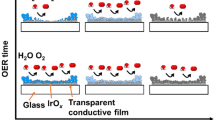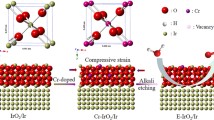Abstract
Several Ir/IrO2 pH electrodes were prepared by a cyclic thermal oxidation process via dip-coating in a concentrated solution of NaOH. A hydrothermal hydration treatment at 220 °C for 24 h was used to address the problematic potential drift that is common in Ir/IrO2 pH electrodes. The electrodes that were treated by the hydrothermal method exhibited good stability and high sensitivity compared to those that were hydrated at room temperature. The reasons for this improvement were investigated by Raman spectroscopy, X-ray photoelectron spectroscopy, and field emission scanning electron microscopy. The results suggested that the hydrothermally treated electrode had a more orderly crystal arrangement and a higher content of OH− groups, which drove improvements in the performance of electrode by modification of the Ir/IrO2 structure. The relationship between the electrode structure and performance was investigated and discussed in detail herein.





Similar content being viewed by others
References
Ding K, William E, Seyfried J (2007) In situ measurement of pH and dissolved H2 in mid-ocean ridge hydrothermal fluids at elevated temperatures and pressures. Chem Rev 107(2):601–622. doi:10.1021/cr050367s
Yu J, Khalil M, Liu N, Lee R (2014) Iridium oxide-based chemical sensor for in situ pH measurement of oilfield-produced water under subsurface conditions. Ionics 21(3):855–861. doi:10.1007/s11581-014-1214-0
Slavcheva E, Schnakenberg U, Mokwa W (2006) Deposition of sputtered iridium oxide-Influence of oxygen flow in the reactor on the film properties. Appl Surf Sci 253(4):1964–1969. doi:10.1016/j.apsusc.2006.03.073
Głab S, Hulanicki A, Edwall G, Ingman F (1989) Metal-metal oxide and metal oxide electrodes as pH Sensors. Crit Rev Anal Chem 21(1):29–47. doi:10.1080/10408348908048815
Fog A, Buck RP (1984) Electronic semiconducting oxides as pH sensors. Sensors Actuators 5(2):137–146. doi:10.1016/0250-6874(84)80004-9
Gottesfeld S, McIntyre JDE, Beni G, Shay JL (1978) Electrochromism in anodic iridium oxide films. Appl Phys Lett 33(2):208. doi:10.1063/1.90277
Song I, Fink K, Payer JH (1998) Metal oxide/metal pH sensor: effect of anions on pH measurements. Corros Sci 54(1):13–19. doi:10.5006/1.3284823
Olthuis W, Robben MAM, Bergveld P (1990) pH sensor properties of electrochemically grown iridium oxide. Sensors Actuators B 2(4):247–256. doi:10.1016/0925-4005(90)80150-X
Baur JE, Spaine TW (1998) Electrochemical deposition of iridium (IV) oxide from alkaline solutions of iridium(III) oxide. J Electroanal Chem 443(2):208–216. doi:10.1016/S0022-0728(97)00532-9
Hasenkamp W, Musa S, Alexandru A, Eberle W, Bartic C (2009) Electrodeposition and characterization of iridium oxide as electrode material for neural recording and stimulation. Springer, Berlin, pp 472–475
Patrick J, Kinlen JEH, Hubbard DE (1994) A solid-state pH sensor based on a Nafion-coated iridium oxide indicator electrode and a polymer-based silver chloride reference electrode. Sensors Actuators B 22(1):13–25. doi:10.1016/0925-4005(94)01254-7
Katsube T, Lauks I, Zemel JN (1982) pH-sensitive sputtered iridium oxide films. Sensors Actuators 2:399–410. doi:10.1016/0250-6874(81)80060-1
Silvano Bordi MC, Papeschi G, Pinzauti S (1984) Iridium/iridium oxide electrode for potentiometric determination of proton activity in hydroorganic solutions at sub-zero temperatures. Anal Chem 56(2):317–319. doi:10.1021/ac00266a051
Papeschi G, Bordi S, Carlà M, Criscione L, Ledda F (2009) An iridium-iridium oxide electrode for in vivo monitoring of blood pH changes. J Med Eng Technol 5(2):86–87. doi:10.3109/03091908109042445
Pan Y, Seyfried WE (2008) Experimental and theoretical constraints on pH measurements with an iridium oxide electrode in aqueous fluids from 25 to 175 °C and 25 MPa. J Solut Chem 37(8):1051–1062. doi:10.1007/s10953-008-9293-z
Huang W-D, Cao H, Deb S, Chiao M, Chiao JC (2011) A flexible pH sensor based on the iridium oxide sensing film. Sensors Actuators A Phys 169(1):1–11. doi:10.1016/j.sna.2011.05.016
Wang M, Yao S (2003) Carbonate-melt oxidized iridium wire for pH sensing. Electroanalysis 15(20):1606–1615. doi:10.1002/elan.200302723
VanHoudt P, Lewandowski Z, Little B (1992) Iridium oxide pH microelectrode. Biotechnol Bioeng 40(5):601–608. doi:10.1002/bit.260400507
Kenneth G, Kreider MJT, Cline JP (1995) Sputtered thin-film pH electrodes of platinum, palladium, ruthenium, and iridium oxides. Sensors Actuators B 28(3):167–172. doi:10.1016/0925-4005(95)01655-4
Chrisanti S (2003) A pH electrode based on melt-oxidized iridium oxide. Dissertation, The Ohio State University
Huang F, Jin Y, Wen L (2015) Investigations of the hydration effects on cyclic thermo-oxidized Ir/IrOx electrode. J Electrochem Soc 162(12):B337–B343. doi:10.1149/2.0571512jes
Trasatti S (1991) Physical electrochemistry of ceramic oxides. Electrochim Acta 36(2):225–241. doi:10.1016/0013-4686(91)85244-2
Michael L, Hitchman SR (1992) A field-induced poising technique for promoting convergence of standard electrode potential values of thermally oxidized iridium pH sensors. Talanta 39(2):137–144. doi:10.1016/0039-9140(92)80008-2
VanHoudt P, Lewandowski Z, Little B (1992) Iridium oxide pH microelectrode. Biotechnol Bioeng 40(5):601–608. doi:10.1002/bit.260400507
Suchanek WL, Riman RE (2006) Hydrothermal synthesis of advanced ceramic powders. Adv Sci Technol 45:184–193. doi:10.4028/www.scientific.net/AST.45.184
Rabenau A (1985) The role of hydrothermal synthesis in preparative chemistry. Angew Chem Int Ed 24(12):1026–1040. doi:10.1002/anie.198510261
Yoshimura M, Byrappa K (2008) Hydrothermal processing of materials: past, present and future. J Mater Sci 43(7):2085–2103. doi:10.1007/s10853-007-1853-x
Juodkazytė J, Šebeka B, Valsiunas I, Juodkazis K (2005) Iridium anodic oxidation to Ir (III) and Ir(IV) hydrous oxides. Electroanalysis 17(11):947–952. doi:10.1002/elan.200403200
Huang YS (1989) Raman spectrum of IrO2. Solid State Commun 70(5):517–522. doi:10.1016/0038-1098(89)90942-3
Musić S, Popović S, Maljković M, Skoko Z, Furić K, Gajović A (2003) Thermochemical formation of IrO2 and Ir. Mater Lett 57(29):4509–4514. doi:10.1016/s0167-577x(03)00352-5
Korotcov AV, Huang Y-S, Tsai D-S, Tiong K-K (2006) Raman scattering characterization of vertical aligned 1D IrO2 nanocrystals grown on single crystal oxide substrates. Solid State Commun 137(6):310–314. doi:10.1016/j.ssc.2005.11.038
Gheeraert E, Deneuville A, Bonnot AM, Abello L (1992) Defects and stress analysis of the Raman spectrum of diamond films. Diam Relat Mater 1(5-6):525–528. doi:10.1016/0925-9635(92)90157-J
Mougin J, Lucazeau G, Galerie A, Dupeux M (2001) Influence of cooling rate and initial surface roughness on the residual stresses in chromia scales thermally grown on pure chromium. Mater Sci Eng A 308(1-2):118–123. doi:10.1016/S0921-5093(00)02037-2
Julie Mougin AG, Lucazeau G, Bracho-Troconis CB (2001) Raman spectroscopy determination of residual stresses at room temperature in chromia scales grown on pure chromium in oxygen and in water vapour. Mater Sci Forum 369-372:841–848. doi:10.4028/www.scientific.net/MSF.369-372.841
Julie Mougin NR, Lucazeau G, Galerie A (2001) In situ Raman monitoring of chromium oxide scale growth for stress determination. J Raman Spectrosc 32(9):739–744. doi:10.1002/jrs.734
Kurpaska L, Favergeon J, Grosseau-Poussard J-L, Lahoche L, Moulin G (2016) In-situ stress analysis of the Zr/ZrO2 system as studied by Raman spectroscopy and deflection test in monofacial oxidation techniques. Appl Surf Sci 385(1):106–112. doi:10.1016/j.apsusc.2016.05.074
Przybilla W, Schütze M (2002) Role of growth stresses on the structure of oxide scales on nickel at 800 and 900 °C. Oxid Met 58(1):103–145. doi:10.1023/A:1016016608591
Birnie J, Craggs C, Gardiner DJ, Graves PR (1992) Ex situ and in situ determination of stress distributions in chromium oxide films by Raman microscopy. Corros Sci 33(1):1–12. doi:10.1016/0010-938X(92)90014-T
Hou PY, Paulikas AP, Veal BW (2009) Growth strains in thermally grown Al2O3 scales studied using synchrotron radiation. JOM 61(7). doi:10.1007/s11837-009-0103-x
Kötz R, Lewerenz HJ, Stucki S (1983) XPS studies of oxygen evolution on Ru and RuO2 Anodes. J Electrochem Soc 130(4):825–829. doi:10.1149/1.2119829
Andrade JD (1985) X-ray photoelectron spectroscopy (XPS). Surface and interfacial aspects of biomedical polymers. Springer, US, pp 105–195
Hall HY, Sherwood PMA (1984) X-ray photoelectron spectroscopic studies of the iridium electrode system. J Chem Soc Faraday Trans 1 Phys Chem Condens Phases 80:135–152. doi:10.1039/F19848000135
Acknowledgments
The author would like to thank the Shanghai Institute of Ceramics, the Chinese Academy of Sciences, and the Inorganic Materials Analysis and Testing Center for supporting this work.
Author information
Authors and Affiliations
Corresponding author
Ethics declarations
This work did not impact on any human or animal rights.
Rights and permissions
About this article
Cite this article
Wang, D., Yang, C., Xia, J. et al. Improvement of the Ir/IrO2 pH electrode via hydrothermal treatment. Ionics 23, 2167–2174 (2017). https://doi.org/10.1007/s11581-017-2058-1
Received:
Revised:
Accepted:
Published:
Issue Date:
DOI: https://doi.org/10.1007/s11581-017-2058-1




